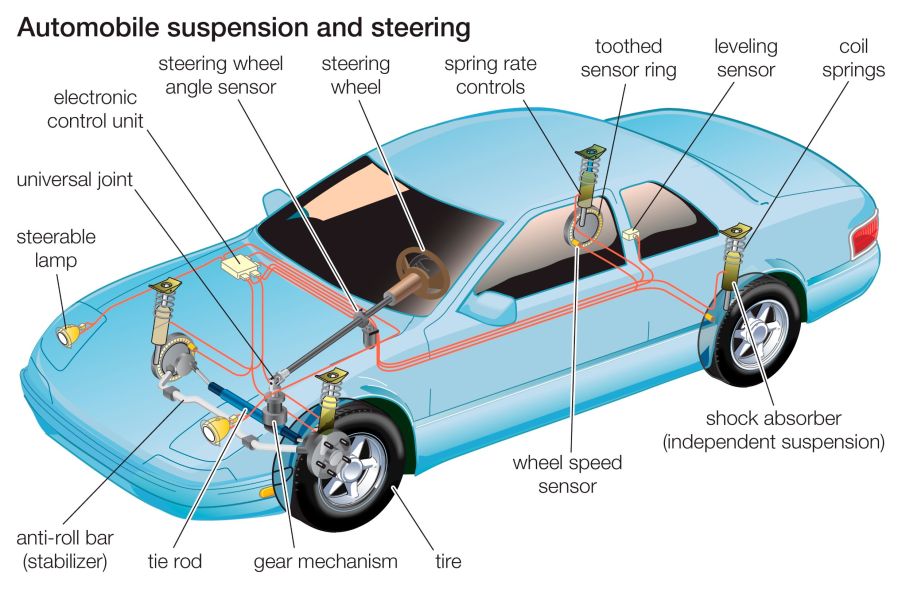
What Does ‘Quick Steering’ Really Mean?
Because the ‘self-driving’ automobile doesn’t exist yet, all cars rely on their drivers to guide them. Which means they need steering wheels and, thus, entire systems. Some cars can even steer all four wheels. And when it comes to sporty cars, oftentimes reviews mention how fast or slow their steering is. But what does that mean?
How does your car’s steering system work?
As with every other aspect of car design, its steering system has evolved over the decades. Today, most cars use what’s known as a rack-and-pinion design, Autoblog reports, though a few heavy-duty vehicles use the older recirculating-ball design, MoogParts reports. This post will focus on the former.

Two pieces form the core of the rack-and-pinion system, Car and Driver explains. There’s the pinion, which is a circular gear, and the steering rack, which is a linear one. The pinion is at the end of the steering column assembly, Cars.com explains, and as you turn the wheel, it meshes with the rack’s grooves.
At each end of the rack is a tie rod, aka a track rod, Haynes explains. This connects to the car’s steering knuckle, which combines the front wheel, suspension, and steering systems, Road & Track explains. When the rack moves, it moves the tie rods, which moves the knuckle, which causes the car to turn.
Nowadays, with very rare exceptions, all cars have power steering systems that connect with the column. So instead of a simple shaft, modern columns connect to the rack via a series of short shafts, universal joints, and motors/actuators, Haynes explains. Plus, sensors to let the system know when the wheel is turning, Autoblog reports.
In hydraulic systems, assistance comes from fluid pressurized by an engine-run pump, YourMechanic explains. As the wheel turns, it passes through a series of valves into hydraulic actuators/pistons located on the rack. Nowadays, though, fuel-efficiency regulations and the rise of ADAS systems has led automakers to switch to electric power steering, Car and Driver reports. Instead of a fluid system, an electric motor attached to the column provides direct assistance.
What makes one car’s steering ‘quicker’ than another?
Quality steering, Car and Driver reports, depends on a multitude of factors. Suspension stiffness, wheel alignment, and the power-assistance system itself all play a role. Which, for EPS-equipped cars, includes software programming, Car and Driver reports. But whether or not a car’s steering is ‘quick’ or not depends on its ratio.
This ratio describes the relationship between steering wheel rotation and actual wheel rotation, Speed Direct explains. So, for example, a 16:1 ratio means for every 1 degree of front wheel rotation, you need to move the steering wheel 16 degrees. The lower the ratio, the less you need to move the steering wheel to turn—thus, quicker steering.
Nowadays, more cars come with variable-ratio steering, Car and Driver reports. At high speeds the ratio increases, so you need greater angles to initiate turns. The upside, though, is better stability. And at low speeds, the ratio decreases so you can make accurate and sharp low-speed turns.
The ratio also affects your car’s ‘lock-to-lock’ measurement, CarBibles reports, i.e., how many times you can rotate the steering wheel before it won’t move. Each car only allows a certain amount of wheel rotation based on its suspension design and tire size. Multiply the ratio by the maximum wheel rotation angle and you have the lock-to-lock measurement.

But there’s another way to make a car’s steering feel faster without changing the ratio: shortening the rack. That’s what Mazda did when it created the Mazdaspeed Miata, Miata.net forum users report. Some assume it was to prevent the tires from rubbing, but others claim it was because the turbo plumbing necessitated the change. Regardless, the shorter rack means lower lock-to-lock, which mimics a lower-ratio, i.e., quicker setup.
Can you modify it, and should you?

Fitting a shorter-than-stock rack is sometimes a necessity, especially if you want to give an older car a more modern system, Grassroots Motorsports reports. However, doing so requires modifying the rest of the steering and suspension components. And that’s not a straightforward process.
However, it’s possible to give your car a different steering ratio, Hemmings reports. It’s a common modification in classic muscle cars as well as modern drift cars, Hemmings and Tuning Blog report. Though it’s worth noting that even with power assistance, changing the ratio also impacts steering effort.
Follow more updates from MotorBiscuit on our Facebook page.


